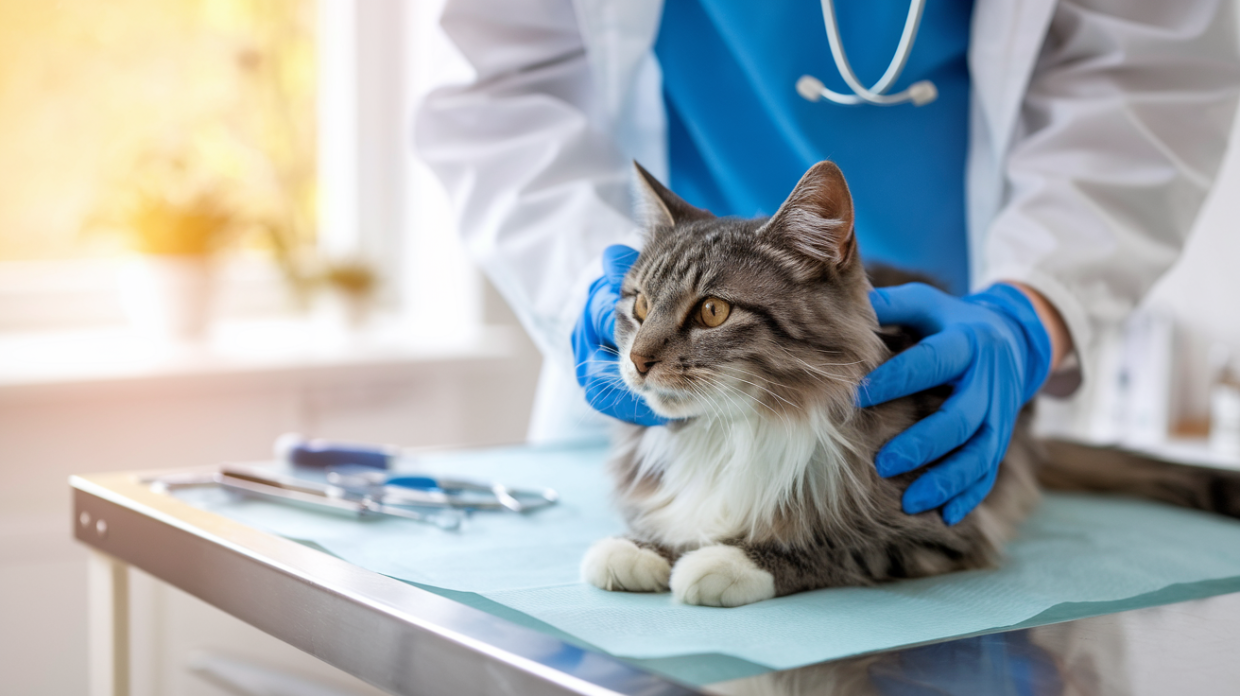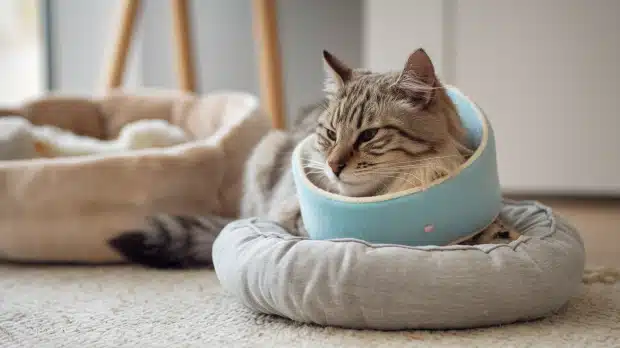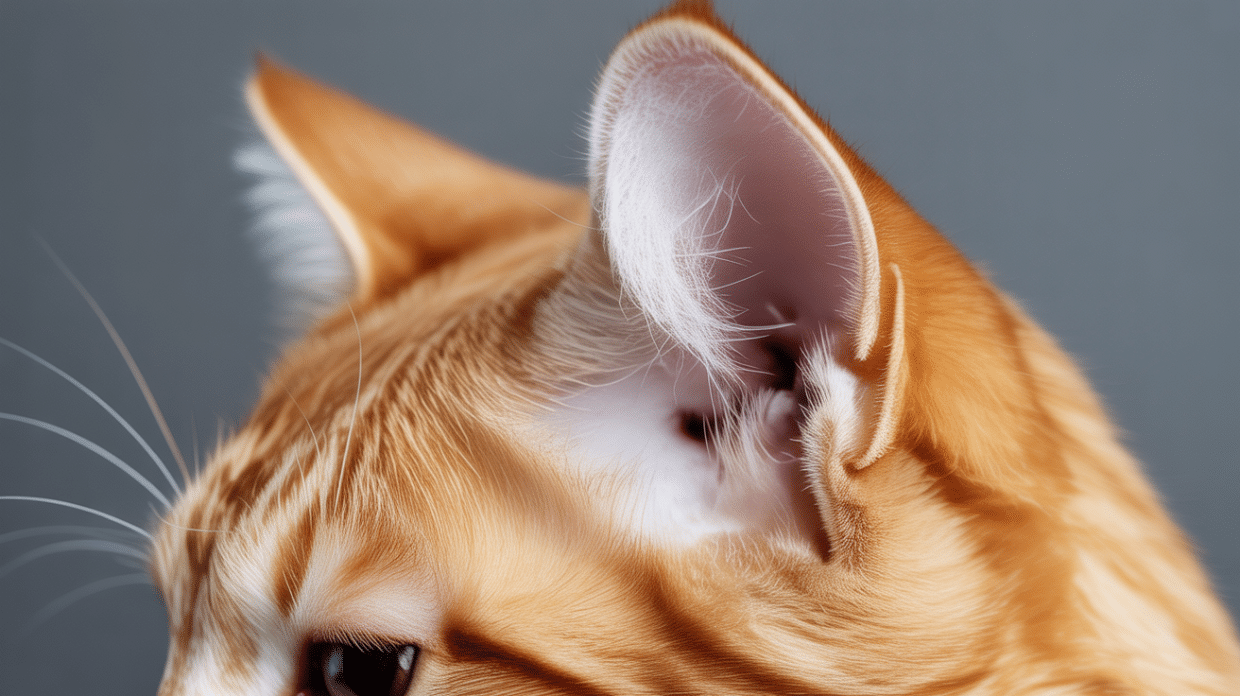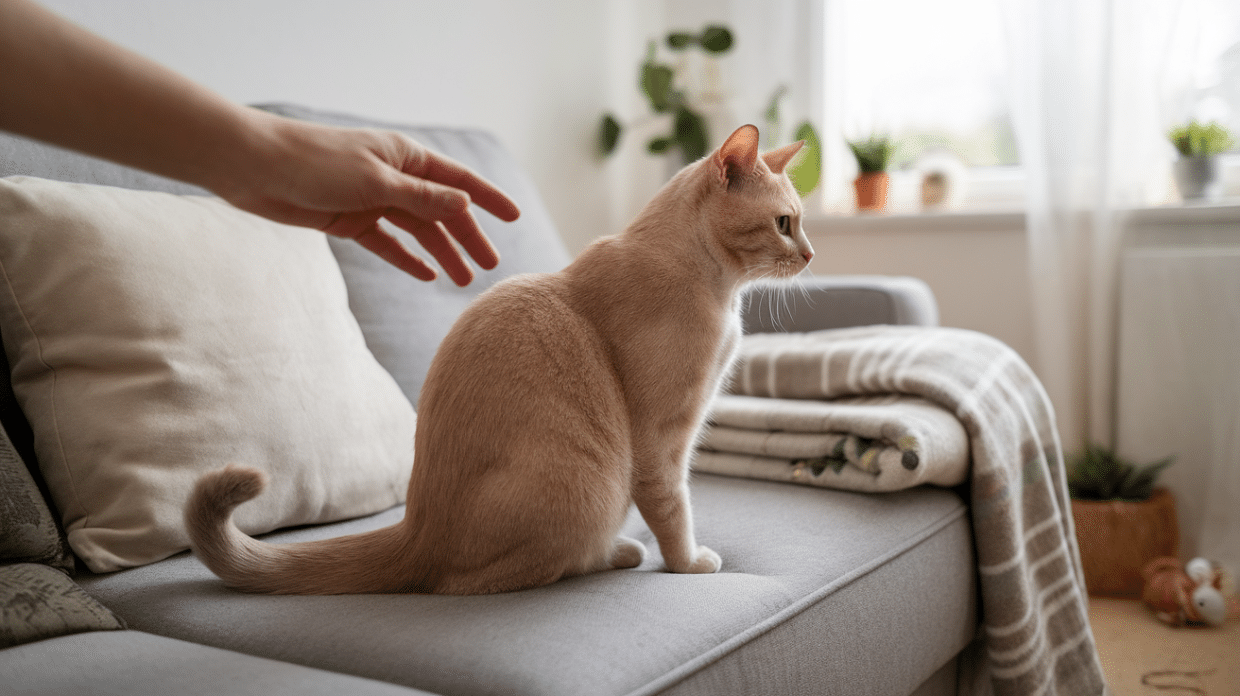Dealing with a cat in heat can be a noisy, stressful experience for any pet owner.
Understanding your cat’s reproductive health is crucial, from constant yowling to the urgent need to escape. Without this knowledge, you may face unexpected litter or unwanted behaviors.
This guide covers everything you need to know about feline reproduction, from how the heat cycle works to the steps you can take to prevent overpopulation.
If you’re considering responsible breeding or want to avoid an unplanned litter, this section offers practical tips on managing your cat’s health.
Read on to learn how to stay in control of your cat’s well-being and make informed decisions for her future.
The Female Cat’s Heat Cycle
The female cat’s heat cycle, known as estrus, occurs when a cat is ready to mate. It can begin as early as 4 months old and may result in multiple litters if not properly managed.
During estrus, female cats display noticeable signs: They roll on the floor, rub against furniture, and often raise their rear end in the air. Their yowling becomes louder and more persistent as they attract male cats.
Most cats experience heat cycles from February to October, taking a break in the winter. Unlike some animals, cats release eggs only after mating, making pregnancy highly likely.
A heat cycle typically lasts between 3 to 20 days, and without mating, a new cycle begins in 10 to 40 days. This rapid cycle explains why a female cat can have many litters in a year, which contributes to the rapid growth of the cat population if not controlled.
Physical and Behavioral Signs of Heat
When a female cat is in heat, her behavior changes significantly. These signs include loud yowling, increased affection, and a strong desire to escape.
Her physical changes, like a swollen rear area, signal her readiness to mate. These behaviors can be intense and can continue for several days.
How a Cat Acts When in Heat
A cat in heat becomes unusually affectionate, rubbing against furniture or people to seek attention.
She may crawl low to the ground with an arched back, often sticking her rear end in the air. This is a mating stance, signaling her desire for male attention.
Her yowling will become loud, frequent, and persistent, often interrupting the peace in your home. Additionally, if she is allowed outside, she may become restless, pacing around and trying to escape.
Her appetite might decrease, and she may lick herself more frequently. These behaviors are all part of her natural cycle and signal her readiness to mate.
The Mating Process of Cats
Male cats track females by scent and sound. A female in heat releases strong signals to attract them.
Mating follows a set pattern. The male grips the female’s neck with his teeth to stay in position. The act lasted less than a minute.
Females often yowl during mating. They can mate with multiple males, leading to mixed-father litters. Each kitten in a litter can have a different father.
Unlike other animals, cats don’t release eggs on a set cycle. Mating triggers egg release, making pregnancy very likely.
Length of Cat Gestation
Cat gestation lasts about 63-65 days, making it relatively short compared to humans. This quick pregnancy period contributes to how fast cat populations can grow, especially outdoors.
Female cats typically become pregnant in the warmer months, particularly during spring when the weather is more favorable for raising kittens.
A female cat can have around 1 to 2 litters each year, with an average of three kittens per litter. However, the number of kittens can vary, with litters ranging from one to as many as six kittens.
This rapid reproductive cycle highlights the importance of spaying or neutering pet cats to control the population and prevent unwanted kittens.
Preparing for Kittens
Create a quiet, private space for your cat to give birth. Provide clean towels, blankets, and supplies for the delivery.
Be prepared to help if needed, and make sure the area is free from distractions and other pets.
Creating a Safe Birth Space
Your pregnant cat needs a quiet, warm, private area to give birth. Set up a box with low sides in a room with little foot traffic.
Line it with clean towels, blankets, or newspapers that can be easily replaced. Ensure the space is away from other pets and noisy areas of your home.
Your cat may choose her spot instead of the one you create, so be ready to move supplies to her desired location.
Supplies Needed for a Cat Giving Birth
Have these items ready before your cat’s due date:
- Clean towels and blankets: These are essential for cleaning up the kittens once they are born. You may also need to help your cat clean them if she’s too tired.
- Newspaper: Use it to line the birthing area, making cleanup easier and more hygienic.
- Paper towels for cleanup: For wiping away fluids or cleaning the area as needed.
- A heating pad set on low: To provide warmth for the kittens after birth, especially if the room is cold. Place it under the bedding, ensuring the heat doesn’t overheat the kittens.
- Clean scissors and unwaxed dental floss: If the mother doesn’t bite the umbilical cord, you may need to do it. Use the scissors to cut the cord and the floss to tie it off, leaving about an inch from the kitten’s belly.
- Iodine solution: Clean the umbilical area after cutting the cord to prevent infection.
- Rubber or latex gloves: To keep things sanitary, especially if you need to assist with the birth or clean a kitten.
- A small scale to weigh kittens: To monitor the health of the kittens by tracking their birth weights.
- A notepad: To record birth times and kitten weights, which can be helpful if you need to consult your vet.
- Your vet’s phone number and emergency vet contact: Always keep this handy in case complications arise during the birth process.
When to Contact a Vet During Pregnancy
Call your vet right away if you notice:
- Green or bloody discharge before kittens appear
- Strong contractions for more than 30 minutes with no kitten being born
- More than 2-3 hours between kittens when you know more are inside
- Your cat seems to be in pain or very tired
- A kitten appears stuck in the birth canal
- Your cat shows signs of illness like fever, vomiting, or not eating
- Labor seems to stop completely before all the kittens are born
Most cats handle birth well independently, but staying nearby to help if needed will give you and your cat peace of mind.
The Birth Process of a Cat
The birth process of a cat unfolds in three stages. Early labor involves nesting behavior, followed by contractions and delivery.
Each kitten is born within minutes, and depending on the litter size, the entire process may take a few hours.
What to Expect During Cat Labor
Cat labor happens in three stages. First, your cat may become restless and stop eating. She will look for a quiet place to give birth.
Nesting behavior begins as she arranges blankets or soft materials. This stage lasts 12 to 24 hours.
In the second stage, contractions start. Your cat may lie on her side, pant, or cry out, and her stomach muscles will tighten.
A fluid-filled sac appears first, followed by a kitten. Most kittens are born headfirst, but some are rear-end first. Both are normal.
Normal Delivery Timeline
Early labor lasts 12 to 24 hours. Once active labor begins, strong contractions follow. Each kitten takes 5 to 30 minutes to be born.
The resting time between kittens lasts 10 to 60 minutes. The entire birth process usually takes 2 to 6 hours, but large litters may take longer.
After birth, the mother cleans each kitten. She removes the sac and bites the umbilical cord. If she doesn’t, you may need to help.
When to Seek Emergency Help
Call a vet if your cat strains for 30 to 60 minutes with no kitten. If more than two hours pass between kittens, get help.
Other warning signs include extreme weakness, heavy bleeding, or a stuck kitten. If contractions last over 20 minutes with no kitten, contact a vet.
Green or dark discharge before all kittens are born is a concern. Labor stopping completely is also a red flag. Fever, shaking, or vomiting means your cat needs help.
How to Support a Cat During Birth
Most cats give birth without help. Stay calm and keep the area quiet. Provide fresh water. Keep other pets and children away. Speak softly to comfort her.
Avoid touching her unless she seeks contact. Have clean towels ready. Track the number of kittens and placentas.
If she doesn’t clean a kitten, gently wipe it. If she is too tired, help move the kittens toward her nipples.
Most cat births go smoothly with care and attention. Knowing when to get help ensures a safe delivery.
Spaying and Neutering Cats
Spaying and neutering are simple surgeries vets do to stop cats from having babies.
These common procedures remove the reproductive organs. Most cats heal quickly and can go home the same day after their surgery.
Benefits of Spaying and Neutering
- Health Benefits: Reduces risk of certain cancers (mammary, uterine, testicular) and prevents uterine infections
- Behavioral Improvements: Decreases unwanted behaviors like spraying, yowling, aggression, and roaming
- Population Control: Prevents unwanted litters and helps reduce the number of homeless cats
- Longer Lifespan: Fixed cats typically live longer, healthier lives than intact cats
The Best Age for the Procedure
- Traditional Recommendation: 5-6 months of age
- Early Spay/Neuter: This can be safely performed at 8-12 weeks for shelter kittens.
- Male Cats: Generally recommended between 4-6 months
- Female Cats: Ideally before the first heat cycle (around 5-6 months)
- Adult Cats: Can be spayed/neutered at any age, though risks increase slightly with age
Recovery Process
- Same-Day Surgery: Most cats go home on the same day as the procedure
- Restricted Activity: 7-10 days of limited jumping and activity
- Monitoring: Check the incision site daily for redness, swelling, or discharge
- E-collar: May be necessary to prevent licking of the surgical site
- Pain Management: The veterinarian will provide the appropriate medication
- Follow-up: Typically 10-14 days after surgery to remove sutures if necessary
Myths and Facts About Fixing Your Cat
Before diving into the myths, it’s essential to separate fact from fiction about spaying and neutering your cat.
Many misconceptions exist, but understanding the truth can help you make informed decisions for your pet’s health and well-being.
Below, we’ve outlined some common myths and the facts to help clarify the importance of these procedures.
| Myth | Fact |
|---|---|
| “My cat should have one litter first.” | Having a litter before spaying has no proven health or behavioral benefits. |
| “Spaying/neutering causes weight gain.” | Weight gain is related to decreased activity and metabolism with age, not the procedure itself. |
| “The procedure will change my cat’s personality.” | Basic personality remains the same; only hormone-driven behaviors are reduced. |
| “Indoor-only cats don’t need to be fixed.” | Even indoor cats benefit from the health and behavioral advantages |
| “It’s too expensive.” | Many low-cost options exist; the cost is less than caring for a litter |
| “It’s cruel or unnatural.” | Lifetime health benefits outweigh the brief discomfort |
Cat Reproduction Rate and How to Manage It
Cats have a high reproduction rate. A female cat can go into heat as early as five months old and have multiple litters yearly.
Each litter may have four to six kittens, sometimes more. If not managed properly, this rapid cycle leads to overpopulation.
Managing Cat Population Responsibly
Spaying and neutering are the most effective ways to control cat reproduction. Fixing a cat early prevents unwanted litter and reduces health risks.
Keeping cats indoors also helps prevent unplanned breeding. Microchipping ensures lost cats return to their owners, reducing stray populations.
Trap-neuter-return (TNR) programs help feral cats by sterilizing them and releasing them back safely.
Alternatives to Breeding
Adoption is a great alternative to breeding. Many cats already need homes, and foster programs allow people to care for them temporarily until they are adopted.
Those who cannot adopt can help through virtual sponsorships or by supporting breed-specific rescues. Volunteering at shelters also makes a big difference in cat welfare.
Resources for Unexpected Litters
Accidental littering occurs, but assistance is available. Many communities provide low-cost spay/neuter services for mother cats after they give birth.
Rescues provide kitten care supplies like milk replacers and bottles, and foster networks can assist in placing kittens in safe homes.
Online resources and social media groups also connect pet owners with support and adoption opportunities.
Supporting Rescue Efforts
Rescue organizations rely on community support. Attending adoption events helps cats find homes.
Donations of food, litter, or funds support shelters. Volunteers with skills like photography or transport can assist in placing cats with loving families.
By working together, we can manage the cat population and ensure every cat gets the care it deserves.
Conclusion
Understanding your cat’s reproductive health is key to being a responsible pet owner. Spaying and neutering not only prevent unwanted litters but also help your cat live a healthier, calmer life.
If you’re dealing with a cat in heat, planning for kittens, or exploring adoption, there are steps you can take to protect your cat and reduce overpopulation.
With the right care and choices, you can make a big difference in your cat’s well-being and your community.
Want more helpful tips and pet care guides? Check out other blogs on our website for information on cat health to breeds.







